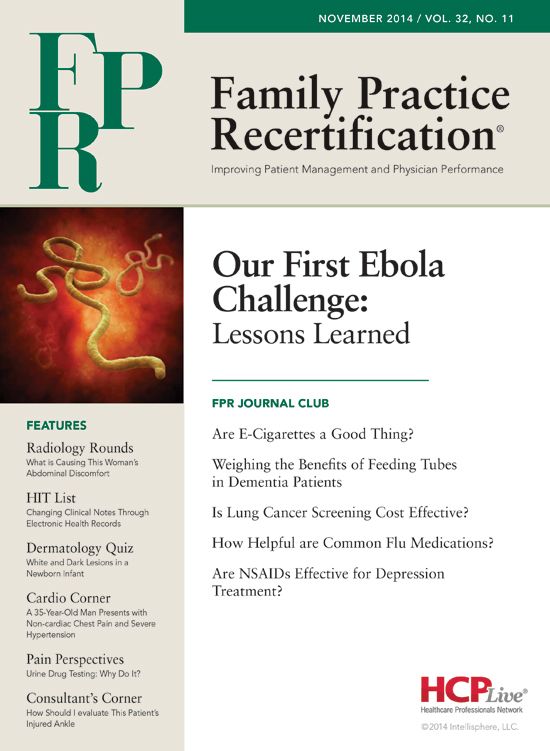Publication
Article
Family Practice Recertification
Our First Ebola Challenge: Lessons Learned
Author(s):
September 30, 2014…this is the date marking the first case of the Ebola virus diagnosed in the United States. In the 6 weeks that followed, Ebola has not only dominated mainstream media attention but also fueled a national health hysteria and panic unseen since HIV in the early 1980s.

September 30, 2014…this is the date marking the first case of the Ebola virus diagnosed in the United States. In the 6 weeks that followed, Ebola has not only dominated mainstream media attention but also fueled a national health hysteria and panic unseen since HIV in the early 1980s.
Although the Centers for Disease Control (CDC) issued and updated evidence-based public health protocols for dealing with the threat of Ebola, a number of states took it upon themselves to implement over-the-top safety measures calling for quarantine and isolation of even asymptomatic individuals traveling to the United States from West Africa.
This group also included health care workers returning from treating Ebola victims, as well as travelers, with and without known exposure to patients with the disease. Such compulsory 21-day quarantines, enacted despite lacking scientific grounds and contradicting CDC guidelines, were widely criticized for their unfair and unnecessary infringement of individual rights on the misguided premise of being necessary to protect the public.
What is the science? Ebola is a virulent RNA filovirus that is one of the causes of hemorrhagic fever. Following an incubation period of 2 to 21 days, though typically closer to 8 to 10 days, the onset of infection by Ebola is heralded by the development of fever and non-specific symptoms like fatigue, myalgia, malaise, headaches, and hiccups for a few days. These symptoms are followed by severe vomiting and watery diarrhea, conjunctival injection, and rash. Laboratory abnormalities include leukopenia, thrombocytopenia, elevated aminotransferases, and coagulation abnormalities indicative of disseminated intravascular coagulation (DIC).
Ebola is a zoonotic disease with African fruit bats most likely serving as the natural reservoir and non-human primates, pigs, and African antelopes playing intermediary roles. Human-to-human transmission occurs following exposure to bodily fluids of infected individuals through abrasions in the skin, exposure of mucosal surfaces, or parental exposure. The infectiousness of the fluid is proportionate to the quantity of the virus in the fluid. Although the virus has been detected in semen, urine, saliva, and breast milk of infected persons, blood, feces, and vomit from symptomatic persons appear the most infectious. Viral levels in blood, vomit and feces are low when symptoms first appear and do not appear to reach infectious levels until after the onset of fever. Case fatality rates of up to 50 to 90% have been reported in Africa, with patients succumbing to severe dehydration, metabolic abnormalities, and septic shock.
What has been the US experience? Although the index case of Thomas Eric Duncan in Texas who had been in Liberia died from his illness, the two nurses infected while caring for him during late stages of his infection recovered. Notably, none of the family or community contacts of these 3 individuals came down with Ebola despite exposure in its preclinical and early stages. The other imported case, a New York physician diagnosed following his return from treating Ebola patients in Guinea, also recovered and none of his community contacts, including his fiancé, were secondarily infected.
It thus appears evident that for this first wave of Ebola in the United States, strict adherence to the infection control protocols developed by the CDC should have been more than adequate for containing the threat and assuring the public. The fact that this was not the case, compelling states to take matters into their own hands and institute draconian measures flying in the face of science, stemmed not from a failure or rejection of the “science” but rather an erosion of confidence in the institutions entrusted with carrying out the functions dictated by the science to contain an outbreak.
After repeatedly reassuring the public that the robust US health system and sanitation practices were more than up to the challenge of containing Ebola, the credibility of the CDC came under doubt when the index case failed to be diagnosed and isolated until 3 days after Duncan’s initial presentation to the Texas Health Presbyterian Hospital emergency room with fever and vomiting and revelation of recent travel to West Africa. The public’s trust in its hospitals was eroded when, after well-publicized assurances from the Texas hospital of how well prepared they were for
Ebola, two of the nurses caring for Duncan came down with Ebola as the result of inadequate personal protective equipment (PPE) and breaches in safety protocols. Subsequent disclosure to the public that one of these nurses was permitted by the CDC to board a commercial airline flight despite developing a low-grade fever while under “voluntary” quarantine resulted in a further decline of public confidence in the CDC.
As the initial outbreak of Ebola in the United States draws to an end, a number of important lessons have been learned. First of all, it is incumbent of the world community to work together to extinguish the current Ebola epidemic in West Africa since the ease of international travel places all countries at risk for its spread.
Second, instead of talking about preparedness, both the CDC and the US health system must cooperatively strive to proficiently and flawlessly execute the infection control measures needed to protect the public and must be forthright with any failings.
Finally, greater efforts need to be made in developing effective vaccines and chemotherapeutic agents against Ebola. After all, the threat of a pandemic from an airborne form of this lethal virus is only a mutation or act of bioterrorism away.






